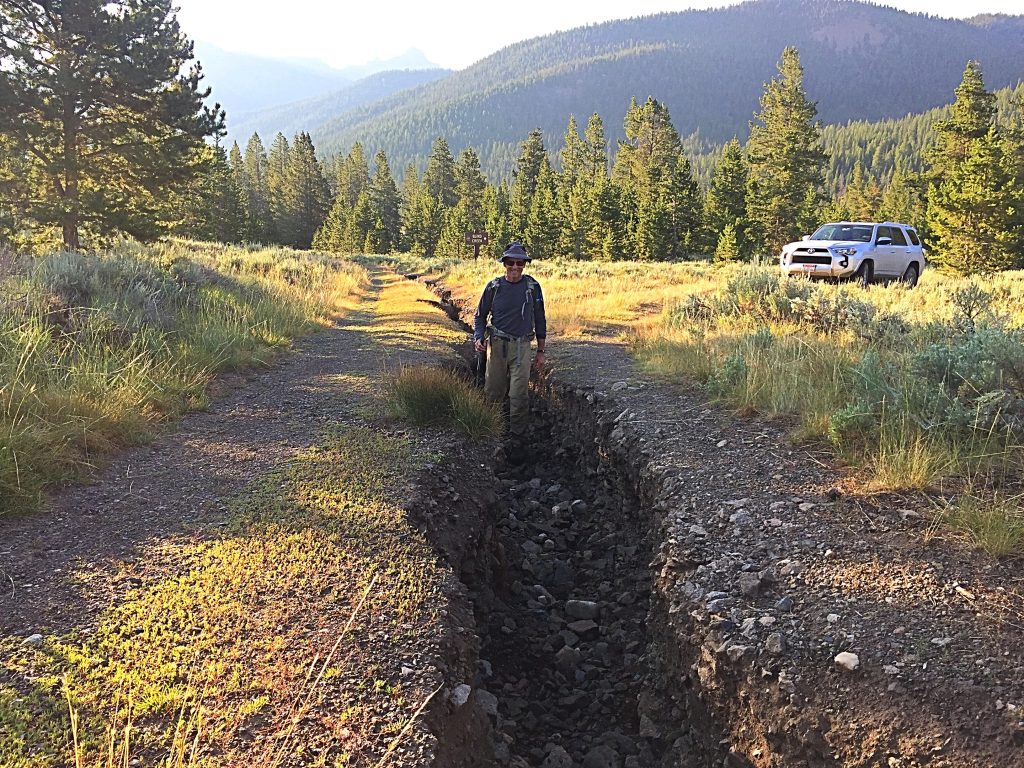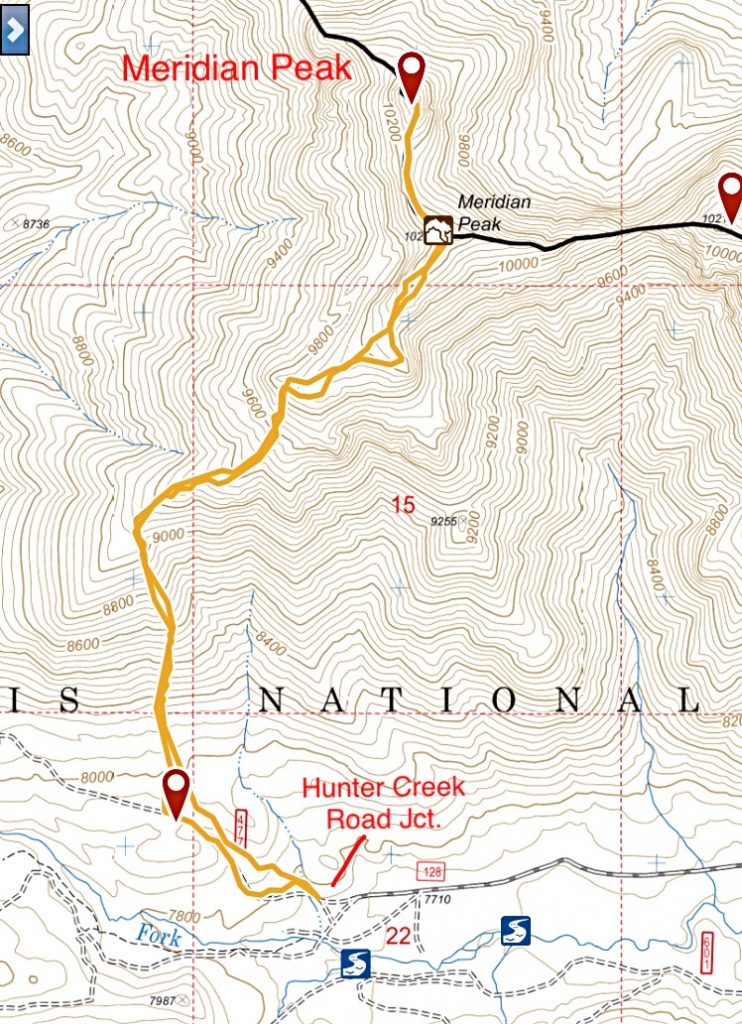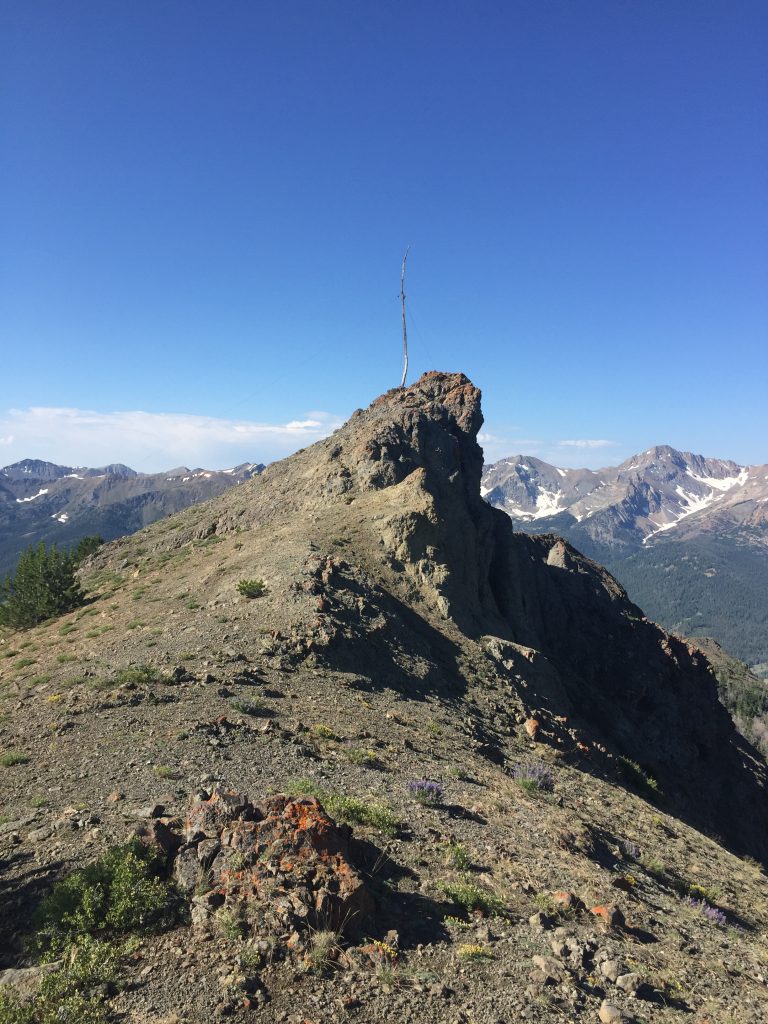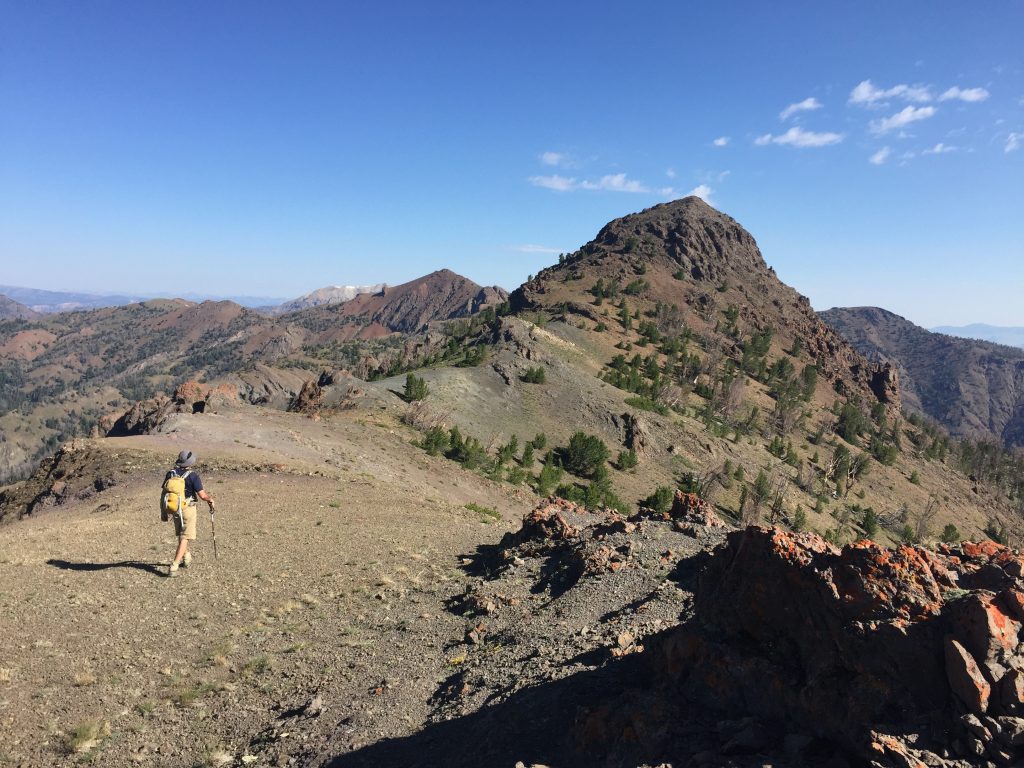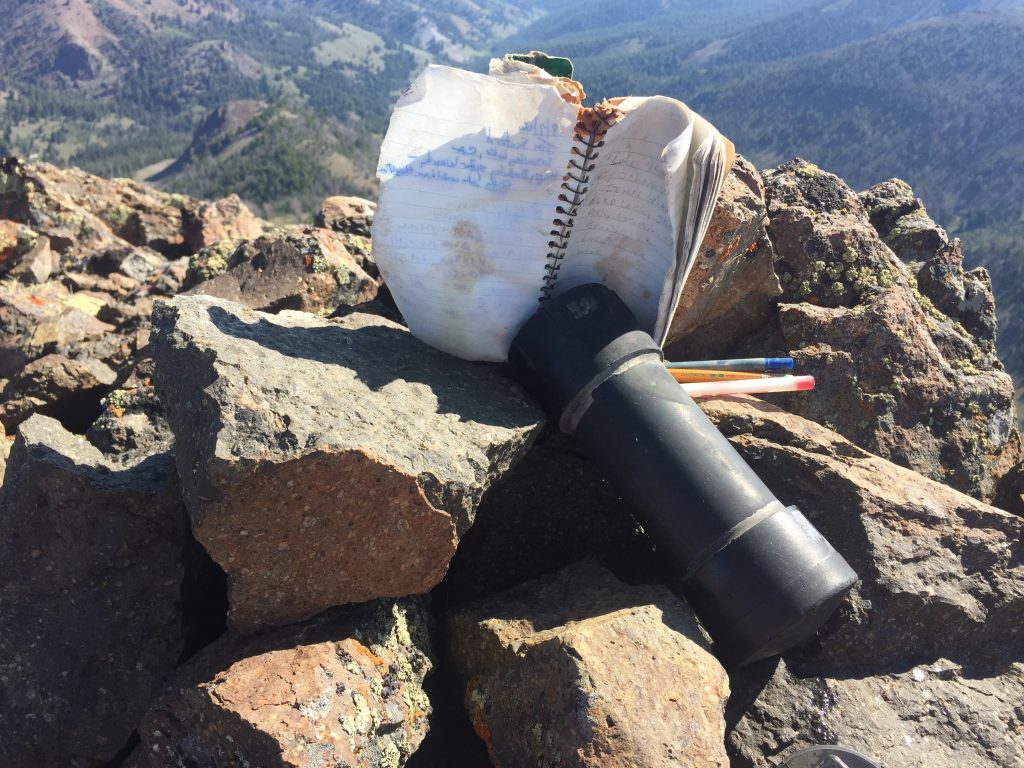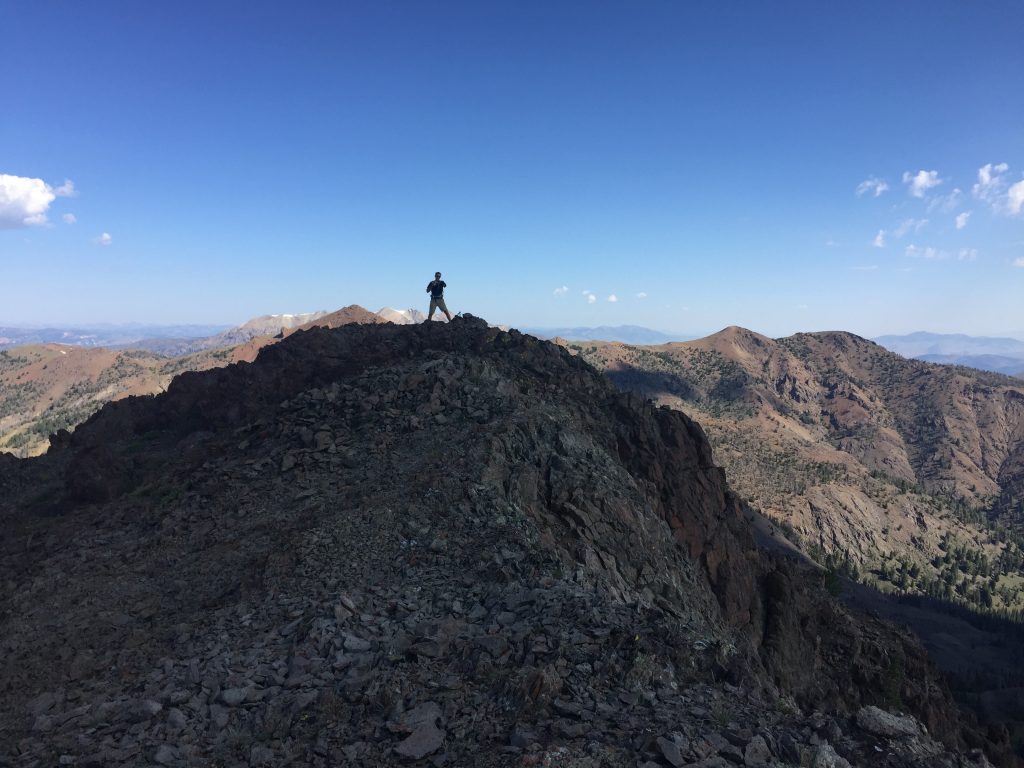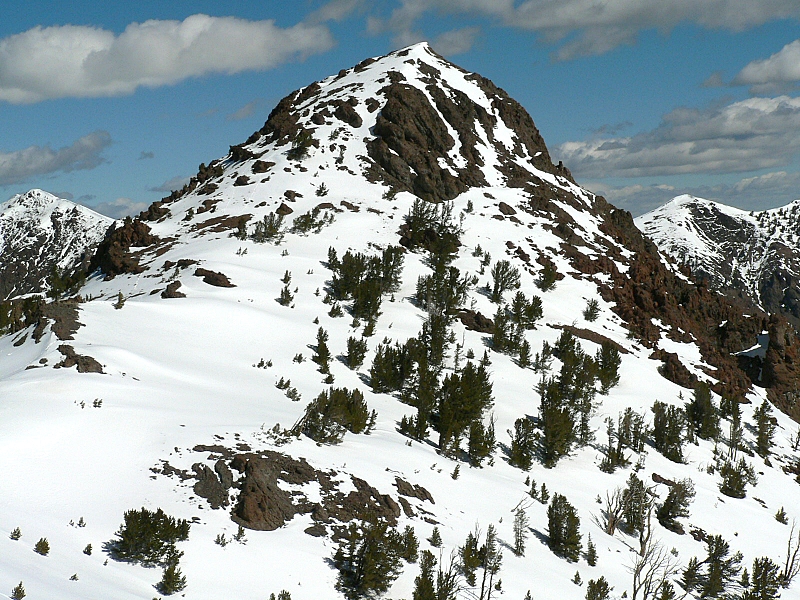Elevation: 10,420 ft
Prominence: 800
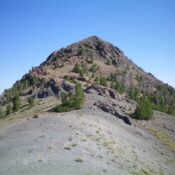
Climbing and access information for Meridian Peak is on Page 233 of the book. I added the more detailed route description below. Livingston Douglas added the Northwest Ridge and South Ridge/Southwest Spur Routes as well as new photos. Updated November 2024
Meridian Peak is the focal point on a massive L-shaped ridge complex. The northern lobe runs north from Meridian Peak to Peak 10522. The eastern lobe that runs east to Toolbox Peak. Middle Canyon and Hunter Creek border the ridge on its western flanks. The East Fork Pass Creek flows on the northern side of the ridge and the North Fork Big Lost River on its southern flanks. Peak 10217 (Meridian East Peak) and Peak 10260 (Meridian Far East Peak) is the easternmost 10er on this ridge system.Various maps incorrectly place the peak’s name on its [lower] South Summit. The [higher] North Summit is found 0.4 miles to the north. USGS Meridian Peak
Access
Primary access to the North Fork of the Big Lost River is via Trail Creek Road [(B) on Page 242]. The road up the North Fork of the Big Lost River [(B)(2)] is a good gravel road that receives occasional maintenance for much of its distance. The headwaters of the North Fork is a vast area with an extensive road system. Some of the roads are closed or impassable, some require a 4WD and some are great.
To access Meridian Peak, stay on the road along the North Side of the river. Follow the road to the Hunter Creek Road [(B)(2)(c) on Page 242]. The route in the book has you drive Hunter Creek Road to its end. Please be advised: The beginning of Hunter Creek Road was seriously damaged and impassable as of July 2017. Now you must walk the road to reach the peak’s southwest ridge.
Alternative Southwest Ridge Route, Class 2
With a significant section of the road washed out, Pat McGrane and I chose to ascend the south flank of the southwest ridge rather than walk the road to the base of the southwest ridge. This decision adds roughly 400 feet of elevation gain, but proves to be a good route. The south flank of the ridge is steep, but the footing is good and the brush is minimal. We gained 1,200 vertical feet from our starting point to the ridge top at 9,000 feet.
Once on the ridge crest, the biggest obstacles are downed trees and one scree slope, which has a nice goat trail on its north side. The ridge takes you to a false summit. Look for old survey remnants here. Cross the false summit and follow the ridge north to the true summit. Our round-trip stats: 5.4 miles with 2,600 feet of elevation gain.
Northwest Ridge and South Ridge/Southwest Spur by Livingston Douglas
Access
Same as for Red Meridian. This is the second leg of a 2-peak adventure that includes Red Meridian (10,522 feet) and Meridian Peak. It covers 9.5 miles with 3,800 feet of elevation gain round trip.
Northwest Ridge, Class 3
The Climb
From the 9,620-foot connecting saddle with Red Meridian, climb southeast up a mix of rock and scrub to reach a massive rocky buttress. Scramble directly up over it (Class 3), staying close to the ridge crest for the most solid rock. Once past this buttress, it is easy going up ridge outcrops, grass/scrub, and scree/gravel to reach the base of the steep, rocky hump that is the summit cap of Meridian Peak. Scramble up Class 3 face rock, chutes, and ribs to reach the summit area. There are two rocky points that vie for the high point. Stand atop both “just to be sure.” The two rocky points are very close to each other. I built a cairn atop the rocky outcrop that I considered to be the higher one.
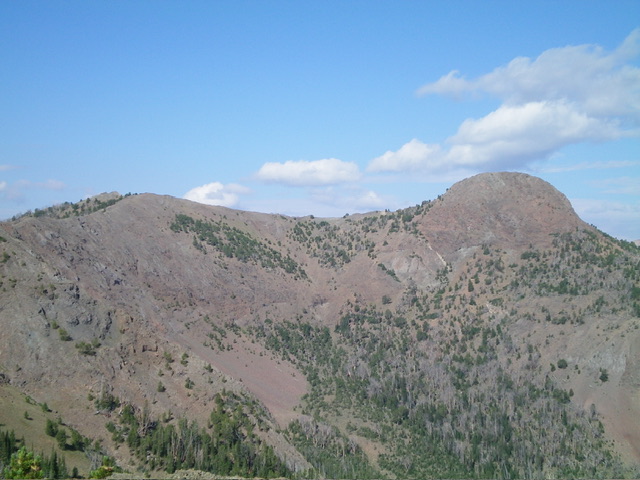
Meridian Peak (summit is right of center), Point 10285/south summit (at far left), and the high connecting ridge. Livingston Douglas Photo
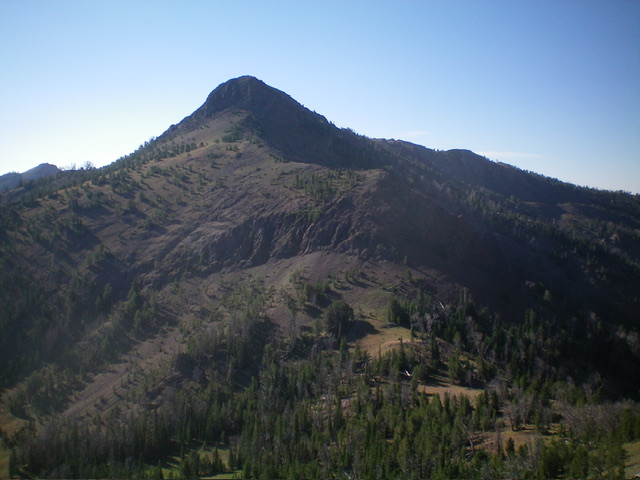
Meridian Peak (left of center) and its northwest ridge (in center and left of center). This was my ascent route. Livingston Douglas Photo
South Ridge/Southwest Spur, Class 3
The Descent
From the summit, descend south down the [initially] narrow, rocky ridge to reach easier grass/gravel terrain. Cross a long, narrow, easy saddle. From the saddle, scramble southeast up to the rocky summit area of Point 10285 (labeled “Meridian Peak” on maps). The high point has a tall branch stuck in it and has guy wires to hold it in place (see Lopez photo). From Point 10285, descend southwest then south on the rock-and-forest ridge. Contrary to the USGS topo map, there are some real sections of pine forest up here. Be sure to bend left/south at about 10,060 feet.
From there, work down through two massive ridge buttresses. Downclimb the right/west side of the first one on face rock and crumbly, loose chutes (Class 3). Downclimb the second buttress on its left/east side in even steeper, looser terrain (Class 3) to reach much easier, forested terrain below. Descend south-southeast through a forested ridge section with annoying loose scree/gravel and equally-annoying thick-ish scrub. Find a narrow, hidden, forested ridge notch just below Point 9255. From that notch, either climb up over Point 9255 or skirt just below the point on its right/west side.
Once past Point 9255, descend southwest down an open sagebrush shoulder (with grass and loose gravel mixed in). This shoulder is steep all the way down to about 8,200 feet. Cross a dry gully and continue southwest, heading straight at the mouth of Blind Creek in the distance. The terrain is now gentle, grass/scrub slopes. Cross a few more dry gullies and come up over a minor forested ridge. From that ridge crossing, descend open scrub back to the road junction and your parked vehicle. The south ridge is a steeper, rockier, more difficult descent route than the southwest ridge used by Baugher and Lopez. I chose a more direct route back to my truck, but not the easiest one.
Additional Resources
Regions: Boulder Mountains->EASTERN IDAHO
Mountain Range: Boulder Mountains
Longitude: -114.32049 Latitude: 43.95001
